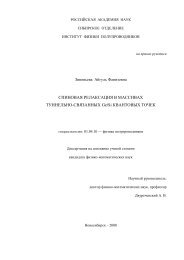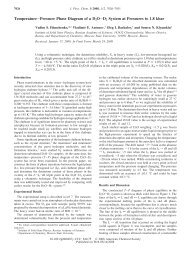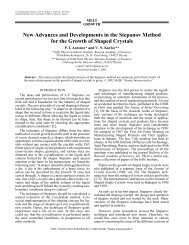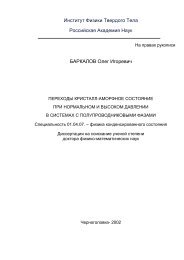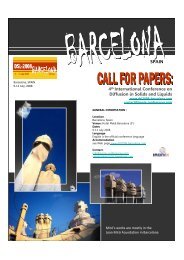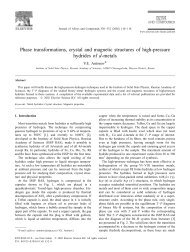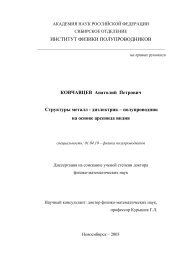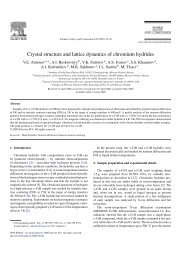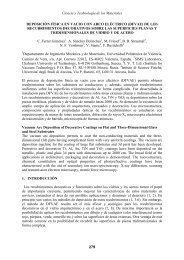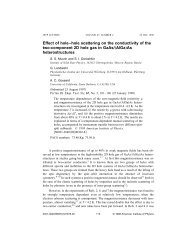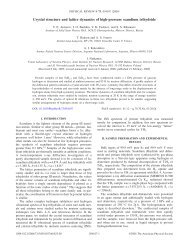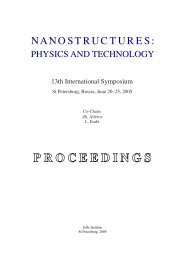340Straumal, Gornakova, Fabrichnaya, Kriegel, Mazilk<strong>in</strong>, Baretzky, Gusak and Dobatk<strong>in</strong>Figure 1. (a) SEM micrograph <strong>of</strong> the as-cast <strong>Zr</strong>-2.5 mass% <strong>Nb</strong> alloy. (b) bright field (left) and dark field (right) TEMmicrographs <strong>of</strong> the HPT-treated <strong>Zr</strong>-8 mass% <strong>Nb</strong> alloy.alloys and the comparison with Ti and Hf alloys was thegoal <strong>of</strong> this work.2 ExperimentalThe <strong>Zr</strong>-<strong>Nb</strong> alloys with 2.5 and 8 mass% <strong>Nb</strong> were <strong>in</strong>vestigated.The alloys were prepared <strong>of</strong> high purity components(4N <strong>Zr</strong> and 4N <strong>Nb</strong>) by the vacuum <strong>in</strong>duction melt<strong>in</strong>g. Themelt was poured <strong>in</strong> the vacuum <strong>in</strong>to the water-cooled cyl<strong>in</strong>dricalcopper crucible <strong>of</strong> 10 mm diameter. After saw<strong>in</strong>g,gr<strong>in</strong>d<strong>in</strong>g, and chemical etch<strong>in</strong>g, the 0.7 mm thick disks cutfrom the as cast cyl<strong>in</strong>ders were subjected to HPT <strong>in</strong> a Bridgmananvil type unit (room temperature, pressure 5 GPa,5 torsions, 1 rotation-per-m<strong>in</strong>ute). After HPT, the central(low-deformed) part <strong>of</strong> each disk (about 3 mm <strong>in</strong> diameter)was excluded from further <strong>in</strong>vestigations. The samplesfor structural <strong>in</strong>vestigations and calorimetry were cut fromthe deformed disks at a distance <strong>of</strong> 4–5 mm from the samplecenter. For this distance the shear stra<strong>in</strong> is 6. The2 mm thick slices were also cut from the cyl<strong>in</strong>drical <strong>in</strong>gots,then divided <strong>in</strong>to four parts. After quench<strong>in</strong>g, samples wereembedded <strong>in</strong> res<strong>in</strong> and then mechanically ground and polished,us<strong>in</strong>g 1 µm diamond paste <strong>in</strong> the last polish<strong>in</strong>g step,for the metallographic study. After etch<strong>in</strong>g, samples were<strong>in</strong>vestigated by means <strong>of</strong> the light microscopy (LM) and byscann<strong>in</strong>g electron microscopy (SEM). SEM <strong>in</strong>vestigationshave been carried out <strong>in</strong> a Tescan Vega TS5130 MM microscopeequipped with the LINK energy-dispersive spectrometerproduced by Oxford Instruments. LM has been performedus<strong>in</strong>g a Neophot-32 light microscope equipped witha 10 Mpix Canon Digital Rebel XT camera. The samplesfor TEM <strong>in</strong>vestigations were prepared by ion mill<strong>in</strong>g onthe PIPS mach<strong>in</strong>e. TEM <strong>in</strong>vestigations were carried out ona TECNAI F2 electron microscope with acceleration voltage<strong>of</strong> 200 kV. The dark field image was taken <strong>in</strong> the mostbright reflection to which contribute both ˛ and ! phases.X-ray diffraction (XRD) data were obta<strong>in</strong>ed on a Siemensdiffractometer (Co K ff radiation). Gra<strong>in</strong> size was estimatedby the XRD l<strong>in</strong>e broaden<strong>in</strong>g and us<strong>in</strong>g the Scherer formula[82]. Both the as-cast coarse-gra<strong>in</strong>ed CG and f<strong>in</strong>egra<strong>in</strong>edHPT-samples were studied with the aid <strong>of</strong> differentialscann<strong>in</strong>g calorimetry (DSC) us<strong>in</strong>g the NETZSCH Pegasus404C calorimeter <strong>in</strong> the dry argon atmosphere, Al 2 O 3crucibles and at the cool<strong>in</strong>g and heat<strong>in</strong>g rates <strong>of</strong> 20 K=m<strong>in</strong>.In order to record the DSC curves, the samples were heatedfrom 100 to 900 ı C. Thermodynamic calculations were performedus<strong>in</strong>g thermodynamic data <strong>of</strong> Guillermet [83] wheresolid solutions bcc and hcp as well as liquid solution weredescribed by substitutional model. The bcc phase was describedas s<strong>in</strong>gle phase which forms miscibility gap <strong>in</strong> thecomposition range from 8 to 81 mass% <strong>Zr</strong> and temperaturesfrom 620 up to 976 ı C. Thermo-calc s<strong>of</strong>tware [84] was usedto calculated equilibrium phase diagrams and diffusionlesstransformation hcp$bcc.3 ResultsFigure 1a shows the SEM micrograph <strong>of</strong> the as-cast <strong>Zr</strong>-2.5 mass% <strong>Nb</strong> alloy. The gra<strong>in</strong> size <strong>in</strong> both CG as-castalloys determ<strong>in</strong>ed with the aid <strong>of</strong> SEM and LM was about100–300µm. Figure 1b shows the bright field and dark fieldTEM micrograph <strong>of</strong> the HPT-treated <strong>Zr</strong>-8 mass% <strong>Nb</strong> alloy.HPT drastically ref<strong>in</strong>ed the gra<strong>in</strong>s. Both <strong>Zr</strong>-<strong>Nb</strong> alloys becameultra-f<strong>in</strong>e gra<strong>in</strong>ed (UFG). Gra<strong>in</strong> size <strong>of</strong> the !<strong>Zr</strong> afterHPT estimated for (111) reflection <strong>in</strong> XRD was about 14 nmand 7 nm for the alloys with 2.5 mass% and 8 mass% <strong>Nb</strong>,respectively (Figure 2). As to the ˇ<strong>Zr</strong>, its gra<strong>in</strong> size was estimatedafter the deconvolution <strong>of</strong> the correspond<strong>in</strong>g peaks,as they are overlapped with those from ˛ and ! phases. Calculationsgave the values <strong>of</strong> 24 nm and 11 nm for the alloyswith 2.5 mass% and 8 mass% <strong>Nb</strong>, respectively.Bereitgestellt von | Karlsruher Institut für Technologie (KIT)Angemeldet | 141.52.94.125Heruntergeladen am | 12.11.12 15:54
<strong>Effective</strong> <strong>Temperature</strong> <strong>of</strong> <strong>High</strong> <strong>Pressure</strong> <strong>Torsion</strong> <strong>in</strong> <strong>Zr</strong>-<strong>Nb</strong> <strong>Alloys</strong> 341Figure 2. XRD curves for the UFG <strong>Zr</strong>-2.5 mass% <strong>Nb</strong> and UFG <strong>Zr</strong>-8 mass% <strong>Nb</strong> allos after HPT.Figure 3. The part <strong>of</strong> the <strong>Zr</strong>-<strong>Nb</strong> equilibrium phase diagram.Dashed l<strong>in</strong>e shows the martensitic martensitic ˛<strong>Zr</strong>$ ˇ<strong>Zr</strong>transformation.XRD-spectra <strong>of</strong> CG as-cast alloys demonstrate that theyconta<strong>in</strong> ma<strong>in</strong>ly ˛<strong>Zr</strong> with hexagonal closely-packed lattice.The <strong>Nb</strong>-rich body-centered cubic phase is absent. Smallamount <strong>of</strong> ˇ<strong>Zr</strong> is present <strong>in</strong> the CG as-cast alloys. <strong>Nb</strong>poorˇ<strong>Zr</strong> has a body-centered cubic lattice and is isomorhousto the <strong>Nb</strong>-rich bcc-phase. The calculated phasediagram (Figure 3) reproduces experimental data [62] verywell. Below the temperature <strong>of</strong> a monotectoid transformationT mon D 620 ı C the stable assemblage is ˇ<strong>Nb</strong> C ˛<strong>Zr</strong>accord<strong>in</strong>g to the <strong>Zr</strong>-<strong>Nb</strong> phase diagram (Figure 3). Abovemonotectoid reaction and composition <strong>Nb</strong> 19mass% and temperatures between monotectoidreaction and critical po<strong>in</strong>t T c D 976 ı C a two-phasearea ˇ<strong>Zr</strong> C ˇ<strong>Nb</strong> (Figure 3) exists. After HPT both f<strong>in</strong>egra<strong>in</strong>ed<strong>Zr</strong>-<strong>Nb</strong> alloys conta<strong>in</strong> ma<strong>in</strong>ly the !<strong>Zr</strong> phase (Figure2). The !<strong>Zr</strong> phase possesses the hexagonal C32 structure[86]. At the diffraction angle 2‚ D 54 ı the peak <strong>of</strong>a !<strong>Zr</strong> (C32) phase is clearly visible without overlapp<strong>in</strong>gwith peaks <strong>of</strong> other phases. ˛<strong>Zr</strong> (hcp-phase) almost disappearedafter HPT. The <strong>Nb</strong>-rich (ˇ<strong>Nb</strong> -phase) is absentboth after and before HPT. All diffraction peaks <strong>of</strong> the ˇ<strong>Zr</strong>phase are very close to the peaks <strong>of</strong> !<strong>Zr</strong> (C32) phase (Figure2). Nevertheless, the positions <strong>of</strong> the diffraction peaksat 2‚ D 60 ı ,76 ı ,91 ı and 105 ı for the <strong>Zr</strong>-2.5 mass% <strong>Nb</strong>alloy after HPT almost perfect co<strong>in</strong>cide with tabulated valuesfor the 201, 300, 220-and 311 peaks for the !<strong>Zr</strong> (C32)phase. In the <strong>Zr</strong>-2.5 mass% <strong>Nb</strong> alloy the same diffractionpeaks are shifted to the right and are positioned betweenthe respective tabulated values for the !<strong>Zr</strong> (C32) and ˇ<strong>Zr</strong>phases. In other words, the amount <strong>of</strong> ˇ<strong>Zr</strong> phase after HPTis much higher <strong>in</strong> the <strong>Zr</strong>-2.5 mass% <strong>Nb</strong> alloy than <strong>in</strong> the<strong>Zr</strong>-8 mass% <strong>Nb</strong> one.Bereitgestellt von | Karlsruher Institut für Technologie (KIT)Angemeldet | 141.52.94.125Heruntergeladen am | 12.11.12 15:54




